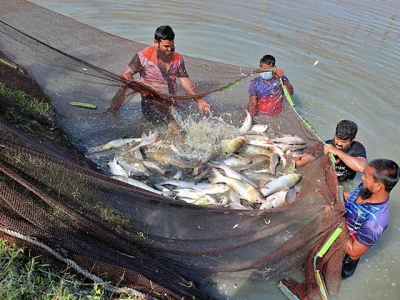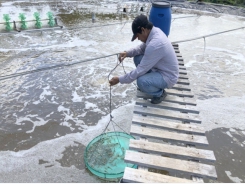Nine ways to produce more sustainable and affordable blue food - Part 1

Conversations around increasing aquatic food production too often focus on species, environments and ambitious hi-tech solutions that will benefit the privileged few.
Carp farmers in Bangladesh. Photo: M Gulam Hussain
A new perspective in One Earth led by Stockholm Resilience Centre researcher Patrik Henriksson and Max Troell, argues that greater attention should be paid to improving the productivity and environmental performance of affordable and accessible aquatic species.
The study details a range of available intervention and investment areas that would significantly and sustainably boost production of these nutritious foods.
Farmed fish can be produced with 87 percent lower greenhouse gas emissions than beef, use 49 percent less land than poultry, and require 84 percent less fresh water than pigs.
At the same time, it has been projected that the production of aquatic foods will increase by 32 percent between 2018 and 2030. But it is not a given that this increase in production will be sustainable.

Improvements in feed composition and efficiency over time for poultry, salmon, tilapia, Chinese carps and marine shrimp. Photo: Henriksson et al
“Fulfilling the potential of aquaculture to contribute positively to food system transformation will require better accounting of the environmental performance of the huge diversity of production systems, and interventions that facilitate upscaling of aquatic farming to support sustainable diets,” say the authors.
Improvements in feed composition and efficiency over time for poultry, salmon, tilapia, Chinese carps, and marine shrimp.
Nine areas of intervention
The study identifies nine intervention areas for improving the productivity and sustainability of global aquaculture:
1. Species choice
2. Genetic improvements
3. Farm technologies and practices
4. Spatial planning and access
5. Disease reduction
6. Feed
7. Regulations and trade
8. Post-harvest processing and distribution
9. Financial tools
“These interventions would have the most impact if geared toward boosting accessible, affordable species,” say the authors.
For example, more tolerant and less resource-demanding species have a lower environmental impact, but are less in demand.
“This could to some extent be overcome by nudging consumer behavior and focusing on value-added products like surimi, which is made from deboned fish paste,” say the authors.
Equally, many smallholder farmers are unable to benefit from quality feed, seed, or disease diagnostics due to limited access to credit.
“Enabling insurance providers and cooperatives could play an important role in alleviating risk and gaining access to credit and markets among smallholder aquaculture farmers,” they add.
"Aquatic foods alone cannot ensure future food security but, if developed thoughtfully, they can play a greater role in alleviating the current food system's environmental pressures on the planet”.
Improving aquaculture's environmental performance
Closing the performance gap in aquaculture appears to hold considerable potential for both productivity and environmental performance gains. Interventions can help to reduce the performance gap in global aquaculture and thereby improve resource-use efficiency, profitability, and overall environmental performance. Interventions that are financially feasible for most farmers are sufficiently scalable to contribute to global change, and importance to food security should be prioritized. As illustrated in Figure 2, and elaborated below, we identify and explore potential effects on farm environmental performance of key interventions in the areas of species choice, genetic improvements, farm technologies and practices, spatial planning and access, disease reduction, feed, regulations and trade, post-harvest processing and distribution, and financial tools.

Figure 2: Mind map of the most promising aquaculture intervention areas
1. Species choice
Different aquaculture species have different physiologies and metabolic characteristics, and consequently have diverse efficiencies and environmental impact profiles under different culture conditions.
Many species are filter feeders, while the nutritional needs of fed species range from largely herbivorous to almost exclusively carnivorous. Meanwhile, optimal farming conditions depend on appropriate temperature and oxygen and salinity levels. For example, some catfishes (Siluriformes) have evolved the ability to gulp air to help meet oxygen needs and can thrive in water containing low levels of dissolved oxygen, making them tolerant of a wide range of growing conditions. In contrast, production of organisms that perform optimally in brackish water (e.g., shrimp) is limited mainly to estuarine zones. The social behavior of the animals also determines what kind of farming environment is needed. For example, solitary animals such as lobsters and some crabs need to be grown separately from one another to avoid cannibalism. Understanding the biology of species, alongside technical solutions, is also key for reproduction in captivity, a prerequisite for selective breeding.
Apart from a capacity for reproducing in farm systems, aquaculture species have historically been chosen based upon their temperature tolerance, resource-use efficiency, feed preferences, and ease of farming. This allowed for low production costs and accessible aquatic foods (defined here as those costing less than half the global production weighted average) (Figure 3). Recently, however, there has been a growing trend toward farming luxury aquatic foods (those costing more than the global weighted average), driven by larger profits, changing consumer preferences, and reduced wild fish supplies. Between these categories, 41 commodity species make up 90% of global production, while another 526 niche species comprise the remaining 10%. We subsequently distinguish four categories of aquatic food species based on market value and production volumes: accessible commodity, accessible niche, luxury commodity, and luxury niche.

Figure 3: Production volumes and value per tonne of whole aquatic animal
Production volumes are dominated by filter-feeding and omnivorous carps, bivalves, tilapia, milkfish, and catfishes, all accessible commodities important for food security and nutrition (lower right quadrant of Figure 3). For fed fish, these are dominated by species that are tolerant to low water quality and can be grown using naturally occurring primary production, agricultural by-products, or food waste as feed. They are primarily sold whole for local or regional markets and, in many cases, destined for household consumption. Bivalves make up a large volume of this group in terms of live wet weight (including shells), but are less important in terms of edible yield.
Among these accessible seafood commodities, there is a shift toward farming more non-indigenous species (e.g., tilapia and Clarias catfish), especially in Asia, something that may pose both ecological (introduction of invasive species) and biosecurity (spread of disease) risks.
In contrast, there are a number of accessible niche species, predominantly other bivalves and omnivorous finfish species, that are more frequently farmed and consumed regionally (lower left quadrant of Figure 3), including mullets, gourami, and green and blue mussels. These also tend to be relatively inexpensive and can therefore make important contributions to regional animal-source food accessibility and food security. Meanwhile, the production of 11 luxury commodity species has been increasing over the past decade. This group consists mainly of naturally carnivorous and omnivorous finfish and crustaceans (upper right quadrant of Figure 3), including shrimp, crayfish, Chinese mitten crab, Atlantic salmon, and rainbow trout. These species are often traded nationally or internationally and are primarily consumed by mid- or high-income consumers. Last, luxury niche species (upper left quadrant of Figure 3) constitute a diverse cluster of species, including abalones, groupers, and Pacific bluefin tuna, among others, that are usually traded internationally and primarily target high-income consumers. These tend to carry disproportionately large environmental footprints, as they are generally resource demanding without benefiting from the efficiency improvements brought by economies of scale. Moreover, luxury species are most likely to be air freighted, which exacerbates greenhouse gas intensity. Notably, while only 16% of the global population lives in high-income countries, they consume over 20% of all aquatic foods produced by capture fisheries and aquaculture.
Selecting more tolerant and less resource-demanding species is therefore a precursor for lowering environmental impacts, but this is inevitably challenged by market demands. This could, to some extent, be overcome by nudging consumer behavior and value-added products (e.g., through deboning).
2. Genetic improvements
There are relatively few distinct strains domesticated for aquaculture, and only around 10% of global production is based upon species that have been improved via selective breeding programs. Meanwhile, there are already commercially available transgenic Atlantic salmon, in which growth-hormone-regulating genes have been replaced by those from Pacific Chinook salmon. Other transgenic aquatic animals are in development.
The main long-term objectives of selective breeding are body conformation, physiological tolerance, edible yield, appearance, disease resistance, reproductivity (age of spawning, sex ratio, and fecundity), resistance to pollution, feed efficiency, and growth rate. Increased growth rate is typically prioritized, and the average genetic growth gain has been estimated at 13% per generation (Table 1), with somewhat lower gains for multi-trait selection. For traditional breeding, the regeneration rate of a species is the major determinant for the selection rate. This has triggered interest in non-traditional genetics techniques, such as CRISPR (clustered regularly interspaced short palindromic repeats). While these techniques could rapidly increase and diversify the selection rate for certain traits, concerns about food safety and ecological risks have resulted in various regulatory frameworks across the world that restrict their implementation.
Table 1: Potential genetic gains from selective breeding of a selection of aquatic species
| Trait | Genetic gain per generation | Order, family, genus, or genus and species |
| Appearance | 4% –46% | Mytilus galloprovosystemis |
| Growth rate | 12,7% (2,3% –42%) | Oreochromis , Cyprinidae, Salmonidae, Perciformes, Siluriformes, Penaeidae, Palaemonidae, Astacoidea, Bivalvia |
| Disease resistance | 6,3% –19% | Oreochromis , Salmonidae, Litopenaeus vannamei , Palaemonidae |
| Reproductivity | 3,3% –11,7% | Oreochromis , Siluriformes, Salmonidae |
| Edible yield | 0,15% –1,7% | Oreochromis , Bivalvia |
Despite the facts that genetic gain per generation is generally higher for aquatic species (Table 1) than terrestrial livestock (reported growth rates of 2.5% for sheep and 4.5% for pig), and regeneration rates are shorter, there are fewer genetically improved strains farmed in aquatic environments than in land-based agriculture and livestock production systems.
This can be explained in part by a shorter history of farming for most of the aquatic species, higher species diversity, smaller market sizes, and more complex life cycles, but also that genetic improvement of most farmed aquatic species has relied on public financing for research and development rather than being industry driven.
For example, while there are commercially developed strains of Atlantic salmon and shrimp, most tilapia and carp strains have been developed and maintained by government institutions, academic institutions, or non-profit organizations (e.g., WorldFish), although there is increasing private sector interest in tilapia genetics. This approach to funding has likely resulted in fewer available strains, which limits the adaptive capacity of farmed aquatic animals to different farming environments.
Allocating more resources toward genetic breeding programs for a more diverse set of aquatic foods could therefore drastically boost production.
Có thể bạn quan tâm
Phần mềm

Phối trộn thức ăn chăn nuôi

Pha dung dịch thủy canh

Định mức cho tôm ăn

Phối trộn phân bón NPK

Xác định tỷ lệ tôm sống

Chuyển đổi đơn vị phân bón

Xác định công suất sục khí

Chuyển đổi đơn vị tôm

Tính diện tích nhà kính

Tính thể tích ao hồ



 Nine ways to produce more sustainable and affordable…
Nine ways to produce more sustainable and affordable…  Fisheries sector sees recovery signs in October
Fisheries sector sees recovery signs in October